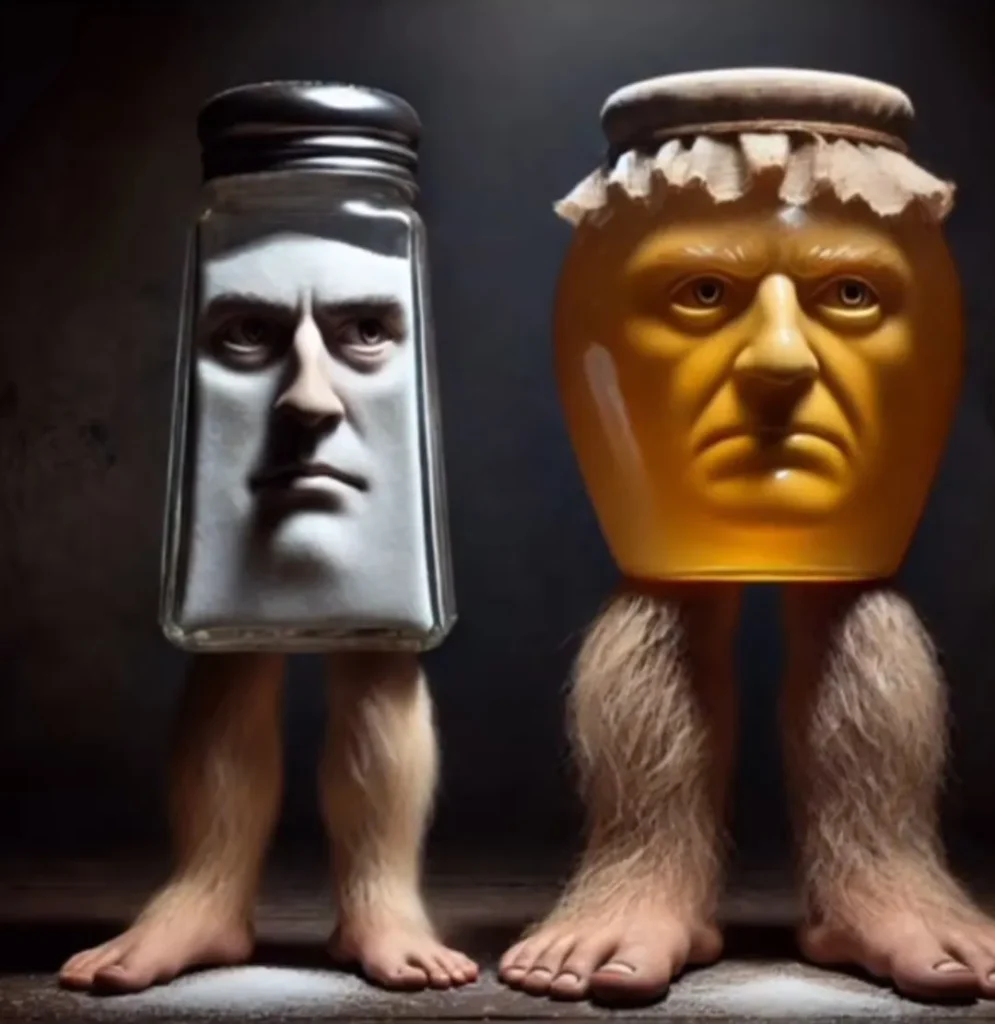
Full Name: Garamararamararaman dan Madudungdung tak tuntung perkuntung
Nicknames: Garamaraman & Madudungdung / Karamaraman & Madungdong
Species: Anthropomorphic salt shaker and honey jar
Gender: Male duo
Music: The Sound of Your Fear
Debut: March 2025
Creator: Unknown (widely shared through TikTok and Indonesian meme spaces)
Origin Language: Indonesian
Cultural Origin: Fusion of Indonesian folklore and Italian Brainrot aesthetics
Character Overview
Garamaraman and Madudungdung are hybrid anomalies—half condiment, half cursed human. Garamaraman, shaped like a weathered salt shaker with a vaguely Elon Musk-like face, is stoic and granular. His companion, Madudungdung, a honey jar with dripping sweetness and a mop of golden hair resembling Donald Trump, carries an eerie gleam of mirth. Both are adorned with thick, hairy human legs and bare, expressive faces.
The characters are part of the larger Brainrot mythology, specifically branching from the Indonesian microcosm of surreal horror-meme hybrids. They personify absurdity and horror wrapped in everyday objects, cursed by obsession and nostalgic indulgence.
Origins and Cursed Lore

Once regular humans, Garamaraman and Madudungdung’s fate was sealed by their overwhelming love for the melancholic Indonesian song “Garam dan Madu” (“Salt and Honey”). During Ramadan, a holy month for Muslims, their obsession led to transformation—becoming permanent anomalies doomed to haunt those who dare play the song at midnight.
According to lore, if the song “Garam dan Madu” is played three times at 12:00 AM, the duo will appear. Their presence is accompanied by a choking silence, followed by the haunting line:
“Malam terus terasa sepi, tak mau sendiri.”
“The night always feels lonely, I don’t want to be alone.”
The Song That Cursed Them: Garam & Madu
Originally performed by Indonesian artist Raykilla, Garam dan Madu is a moody, romantic track that explores the bittersweet duality of love. The title translates to Salt and Honey, representing the mix of pain and pleasure found in deep emotional bonds.
In the Brainrot mythos, the song is not just a soundtrack but a trigger—serving as a portal between the mundane and the uncanny. Its sorrowful lyrics and slow, nostalgic rhythm are said to summon the anomalies from wherever they slumber, particularly during spiritual or emotionally heightened times.
This peculiar connection to a real song blurs the lines between fiction and folklore, grounding the horror in real-world rituals and pop culture phenomena.
Canonical Text and Dialogue
Original (Indonesian)
Garamaraman dan Madudungdung tak tuntung perkuntung, anomali yang mengerikan muncul pada bulan puasa. Dia hanya seorang biasa dulunya namun, karena sakingnya cintanya dengan lagu Garam dan Madu, dia dikutuk seperti ini. Kalau ada orang yang memutar lagu Garam dan Madu jam 12 malam, dia akan ditanggi oleh dia.
“Malam terus terasa sepi, tak mau sendiri.”
English Translation
Garamaraman and Madudungdung, who normally do not cause trouble, experienced a terrible anomaly during Ramadan. They were just ordinary people before, but due to their intense love for the song “Garam dan Madu,” they were cursed like this. Now, if someone plays the song “Garam dan Madu” at midnight, they will be haunted by them.
“The night always feels lonely, I don’t want to be alone.”
Cultural Symbolism and Interpretation
This character pairing reflects an Indonesian take on Italian Brainrot themes—satirical horror, transformation through media, and objects becoming avatars of emotional imbalance. Salt and honey, opposites in flavor, become metaphors for a relationship so intense it leads to self-destruction.
By giving them human faces resembling political figures, the meme further blurs humor, horror, and critique—possibly commenting on digital dependency, populism, and indulgent nostalgia.
Role in Brainrot Ecosystem
Garamaraman and Madudungdung exist alongside figures like Tung Tung Sahur and Tralalero Tralala, forming the Indonesian spiritual-horror branch of the Brainrot multiverse. Their presence is largely atmospheric—rare, ritualistic, and driven by sound. They don’t chase or scream; they wait in silence until summoned.
This passivity adds to the dread—they do not haunt out of hatred, but out of longing. They remind the audience of how far obsession can warp identity.
TikTok and Meme Spread
The characters gained traction on TikTok through AI-generated videos with atmospheric horror music and slow zooms on uncanny faces. Variants of the meme surfaced in other formats—animations, duet stitches, and satirical remixes where the characters dance or react to users playing the song Garam dan Madu.
Despite their grotesque nature, Garamaraman and Madudungdung have become a cultural shorthand for emotional overattachment and meme-fueled doom.
Conclusion
Garamararamararaman dan Madudungdung tak tuntung perkuntung are more than just visual gags. They represent a unique convergence of music, folklore, and meme culture. Their cursed story, rooted in real music and transformed by digital creativity, showcases how Internet mythology continues to evolve—with humor, horror, and cultural crossover at its core.
